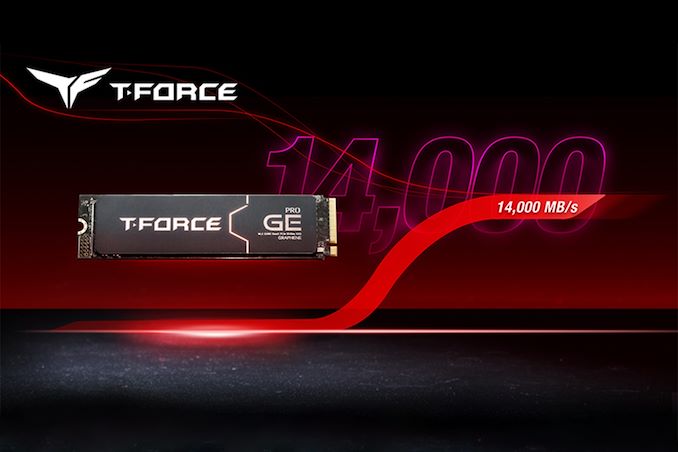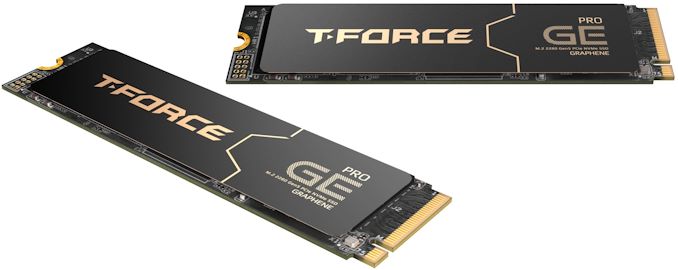TeamGroup Reveals 14GB/s Innogrit IG5666-Based T-Force Ge Pro PCIe 5.0 SSD
by Anton Shilov on January 26, 2024 8:00 AM EST
Virtually all client SSDs with a PCIe 5.0 x4 interface released to date use Phison's PS5026-E26 controller. Apparently, TeamGroup decided to try something different and introduced a drive powered by a completely different platform, the Innogrit IG5666. The T-Force Ge Pro SSD not only uses an all-new platform, but it also boasts with fast 3D NAND to enable a sequential read speed of up to 14 GB/s, which almost saturates the PCIe 5.0 x4 bus.
TeamGroup's T-Force Ge Pro PCIe 5.0 SSDs will be among the first drives to use the Innogrit IG5666 controller, which packs multiple cores that can handle an LDPC ECC algorithm with a 4096-bit code length, features low power consumption, has eight NAND channels, is made on a 12 nm-class process technology, and has a PCIe 5.0 x4 host interface. The drives will be available in 1 TB, 2 TB, and 4 TB configurations as well as will rely on high-performance 3D TLC NAND memory with a 2400 MT/s interface speed to guarantee maximum performance.

Indeed, 2 TB and 4TB T-Force Ge Pro drives are rated for an up to 14,000 MB/s sequential read speed as well as an up to 11,800 MB/s sequential write speed, which is in line with the highest-end SSDs based on the Phison E26 controller. Meanwhile, TeamGroup does not disclose random performance offered by these SSDs.
What is noteworthy is that to T-Force Ge Pro drives are equipped with a simplistic graphene heatspreader, which is said to be enough to sustain such high-performance levels under loads. Usage of such a cooler makes it easy to fit a T-Force Ge Pro into almost any system, a major difference with many of Phison E26-based drives. Of course, only reviews will reveal whether such a cooling system is indeed enough to properly cool the SSDs, but the fact that TeamGroup decided to go with a thin cooler is notable.
TeamGroup is set to offer its T-Force Ge Pro SSDs with a five-year warranty. Amazon, Newegg, and Amazon Japan will start taking pre-orders on these drives on February 9, 2024. Prices are currently unknown.
Source: TeamGroup











11 Comments
View All Comments
meacupla - Friday, January 26, 2024 - link
I am surprised to see TEAM picking up Innogrit. They are a reputable, cost-effective, and trouble-free brand for RAM and SSDs.Innogrit's Gen4 controller, IG5236, was a bad product. It ran hot and would corrupt itself beyond repair without firmware updates. Some SSD makers didn't even offer a firmware update.
I guess TEAM is be confident they can tame the IG5666, or Innogrit has substantially improved their Gen5 design.
Dizoja86 - Saturday, January 27, 2024 - link
The IG5236 was definitely not a "bad product". It's been used and continues to be used in some of the most reasonably priced 4.0 NVME drives that compete with WD and Samsung's high end. It also does so both with and without heatsinks so you're definitely overstating the powerdraw.What's the evidence of it corrupting data as standard practice (so aside from anecdotes)?
meacupla - Saturday, January 27, 2024 - link
Yeah, there are only a bunch of threads about it dying suddenly.https://www.reddit.com/r/buildapc/comments/1607f07...
https://www.reddit.com/r/buildapc/comments/sx37ic/...
https://forums.tomshardware.com/threads/the-bios-s...
related
https://pcpartpicker.com/forums/topic/431121-smart...
Samus - Saturday, January 27, 2024 - link
I've never thought of Team as a reputable trouble-free brand. They are bottom-barrel, even worse than ADATA. While these low end brands have had decent products, their warranty process is terrible and most of their products have questionable quality, with a few occasional hits.Dizoja86 - Saturday, January 27, 2024 - link
There are a bunch of threads about Samsung 980 Pro's and other companies drives dying as well. Reddit is not useful data, and definitely not solid enough evidence to call the IG5236 a bad chip.They've sold millions of those things. You'd expect more reporting if there was actually a fundamental flaw with the chip.
rahvin - Sunday, January 28, 2024 - link
Several cloud providers provide annual storage failure rates. Some of the drives in the reports are in the 10's of thousands and provide reliable and comprehensive failure rates. Problem is it's generally enterprise gear, not consumer.But every brand goes through production issues, by watching the reports before purchasing you can possibly avoid these issues (remember RNG always plays a role). Problem is the reports generally are annual so they are only good for a couple months but I've found they are very good at identifying issues. They reliably showed Seagate was having issues after the Thailand floods and the move of production to China. After about a year they showed Seagate solved the issues and WD began having issues. These always go in cycles.
Same goes for SSD's IMO, you need to find someone using thousands of them if you want to know actual failure and issue rates. Otherwise it's all anecdotal and not worth relying on.
Samus - Friday, February 2, 2024 - link
Diz, there are a bunch of threads about all generations of Samsung drives dying because Samsung drives are total shit.They haven't made a reliable SSD in a decade, having lost virtually every major OEM. Between firmware bugs, controller defects and manufacturing issues, they have had a LOT of doozies. The QC is questionable after the defective batch of 870's years back that went out. As a vertically integrated company its embarrassing they can't get it together and frankly Hynix\Solidigm and WD\Sandisk just do it better in that regard. Samsung isn't really bothered by this because their focus is on volume, ie, the mobile market, supplying NAND to everyone from Apple to themselves. This is self-evident by simple sales figures: Samsung is not a leading volume SSD producer, but is among the largest suppliers of NAND in the world.
croc - Sunday, January 28, 2024 - link
4TBhas same throughput as 2TB? I'll pass, TYVM....Reflex - Monday, January 29, 2024 - link
Um, you know that it's right up against the max throughput for the interface, right? Not sure what the point would be of upping the throughput when it's going to be bottlenecked at the bus anyway...artifex - Sunday, January 28, 2024 - link
Hopefully they send you a sample to test.